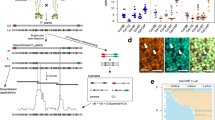Abstract
We have used artificial 1∶1 DNA mixtures of all pairwise combinations of four doubled haploid Brassica napus lines to test the ability of RAPDs to function as reliable dominant genetic markers. In situations where a specific RAPD band is present in one homozygous line but absent in the other, the band is expected in the artificial heterozygote, i.e. in the 1∶1 DNA mixture. In 84 of all 613 heterozygous situations analysed, the expected band failed to amplify in the RAPD reaction. Thus, RAPD markers will lead to an erroneous genetic interpretation in 14% of all cases. In contrast, the formation of non-parental heteroduplex bands was found at a frequency of only 0.2%. Analysis of 1∶ 1 mixtures using (1) a different set of optimized reaction conditions and (2) a material with low genomic complexity (Bacillus cereus) gave identical results. Serial dilutions of one genome into another, in steps of 10%, showed that all of the polymorphic bands decreased in intensity as a linear function of their respective proportion in the mixture. In dilutions with water no differences in band intensity were detected. Thus, competition occurs in the amplification of all RAPD fragments and is a major source of genotyping errors in RAPD analysis.
Similar content being viewed by others
References
Ausubel FM, Brent R, Kingston RE, Moore DD, Seidman JG, Smith JA, Struhl K (1989) Current protocols in molecular biology, vol 1. Green Publishing Assoc & Wiley Interscience, New York
Ayliffe AM, Lawrence GJ, Ellis JG, Pryor AJ (1994) Heteroduplex molecules formed between allelic sequences cause nonparental RAPD bands. Nucleic Acids Res 22:1632–1636
Carlson JE, Tulsieram LK, Glaubitz JC, Luk VWK, Kauffeldt C, Rutledge R (1991) Segregation of random amplified DNA markers in F1 progeny of conifers. Theor Appl Genet 83:194–200
Delourme R, Bouchereau A, Hubert N, Renard M, Landry BS (1994) Identification of RAPD markers linked to a fertility restorer gene for the Ogura radish cytoplasmic male sterlity of rapeseed (Brassica napus L.) Theor Appl Genet 88:741–748
Echt CS, Erdahl LA, McCoy TJ (1992) Genetic segregation of random amplified polymorphic DNA in diploid cultivated alfalfa. Genome 35:84–87
Giovannoni JJ, Wing RA, Ganal MW, Tanksley S (1991) Isolation of molecular markers from specific chromosomal intervals using DNA pools from existing mapping populations. Nucleic Acids Res 19:6553–6558
Halldén C, Nilsson NO, Rading IM, Säll T (1994) Evaluation of RFLP and RAPD markers in a comparison of Brassica napus breeding lines. Theor Appl Genet 88:123–128
Heun M, Helentjaris T (1993) Inheritance of RAPDs in F1 hybrids of corn. Theor Appl Genet 85:961–968
Hjerdin A, Säll T, Tuvesson S, Halldén C (1994) RFLP markers in the genus Beta: characterization of DNA sequences from a Beta vulgaris library. Genetica 92:91–99
Hu J, Quiros CF (1991) Identification of broccoli and cauliflower cultivars with RAPD markers. Plant Cell Rep 10:505–511
Hunt GJ, Page RE (1992) Patterns of inheritance with RAPD molecular markers reveal novel types of polymorphism in the honey bee. Theor Appl Genet 85:15–20
Lamboy WF (1994) Computing genetic similarity coefficients from RAPD data: correcting for the effects of PCR artefacts caused by variation in experimental conditions. PCR Methods Appl 4:38–43
Mailer RJ, Scarth R, Fristenski B (1994) Discrimination among cultivars of rapeseed (Brassica napus L.) using DNA polymorphisms amplified from arbitrary primers. Theor Appl Genet 87:697–704
Michelmore RW, Paran I, Kesseli RV (1991) Identification of markers linked to disease-resistance genes by bulked segregant analysis: a rapid method to detect markers in specific genomic regions by using segregating populations. Proc Natl Acad Sci USA 88:9828–9832
Penner GA, Bush A, Wise R, Kim W, Domier L, Kasha K, Laroche A, Scoles G, Molnar SJ, Fedak G (1993) Reproducibility of random amplified polymorphic DNA (RAPD) analysis among laboratories. PCR Methods Appl 2:341–345
Reiter RS, Williams JGK, Feldmann KA, Rafalski JA, Tingey SV, Scolnik PA (1992) Global and local genome mapping in Arabidopsis thaliana by using recombinant inbred lines and random amplified polymorphic DNAs. Proc Natl Acad Sci USA 89: 1477–1481
Riedy MF, Hamilton WJ, Aquadro FC (1992) Excess of non-parental bands in offspring from known primate pedigrees assayed using RAPD PCR. Nucleic Acids Res 20:918
Stiles JI, Lemme C, Sondur S, Morshidi MB, Manshardt R (1993) Using randomly amplified polymorphic DNA for evaluating genetic relationships among papaya cultivars. Theor Appl Genet 85:697–701
Säll T, Nilsson NO (1994) The robustness of recombination frequency estimates in intercrosses with dominant markers. Genetics 137:589–596
Tinker NA, Fortin MG, Mather DE (1993) Random amplified polymorphic DNA and pedigree relationships in spring barley. Theor Appl Genet 85:976–984
Weeden NF, Timmerman GM, Hemmat M, Kneen BE, Lodhi MA (1992) Inheritance and reliability of RAPD markers. In: Hoisington D, McNab A (eds) Proc Symp Appl RAPD Technol Plant Breed, Crop Sci Soc Am, Minneapolis, pp 12–17
Welsh J, McClelland M (1990) Fingerprinting genomes using PCR with arbitrary primers. Nucleic Acids Res 18:7213–7218
Williams JGK, Kubelik AR, Livak KJ, Rafalski JA, Tingey SV (1990) DNA polymorphisms amplified by arbitrary primers are useful as genetic markers. Nucleic Acids Res 18:6531–6535
Williams JGK, Hanafey MK, Rafalski JA, Tingey SV (1993) Genetic analysis using random amplified polymorphic DNA markers. Methods Enzymol. 218:705–740
Author information
Authors and Affiliations
Additional information
Communicated by J. Beckmann
Rights and permissions
About this article
Cite this article
Halldén, C., Hansen, M., Nilsson, N.O. et al. Competition as a source of errors in RAPD analysis. Theoret. Appl. Genetics 93, 1185–1192 (1996). https://doi.org/10.1007/BF00223449
Received:
Accepted:
Issue Date:
DOI: https://doi.org/10.1007/BF00223449




